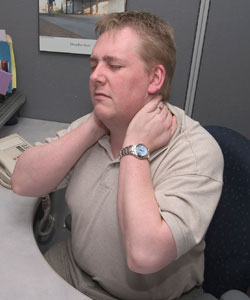
In today’s work environment, many people spend their days sitting in front of a computer, which can greatly contribute to neck and back pain. However, optimizing your posture and environment will decrease the strain on your spine. Therefore, it is important to learn how to improve your own functioning and body awareness and discover how to sit well.
Neck Posture
 Even though you may start out with great posture, over the course of the day, fatigue sets in, and you may inadvertently start to slouch, rolling your shoulders forward and extending your neck forward and up. This causes the small muscles at the base of your head to tighten and spasm, leading to headaches and neck pain. If you perform an improper posture repetitively or for a prolonged time, it can also lead to joint dysfunction and compensatory movements – meaning that some joints may move less or more than others. Also, the deep neck flexor muscles that provide stabilization for the spine may become inhibited due to pain and may need to be retrained to function optimally.
Even though you may start out with great posture, over the course of the day, fatigue sets in, and you may inadvertently start to slouch, rolling your shoulders forward and extending your neck forward and up. This causes the small muscles at the base of your head to tighten and spasm, leading to headaches and neck pain. If you perform an improper posture repetitively or for a prolonged time, it can also lead to joint dysfunction and compensatory movements – meaning that some joints may move less or more than others. Also, the deep neck flexor muscles that provide stabilization for the spine may become inhibited due to pain and may need to be retrained to function optimally.
Optimally, both sides of the spine should move equally. Some useful exercises and tips to help deal with these issues include:
- Deep neck flexor activation – Sit tall and try to slide the back of your head up toward the ceiling. Your chin may go down slightly, but the movement should be very slight. You should not feel the muscles in the front of your neck contracting. Hold for 5-10 seconds and repeat 10 times.
- Shoulder retractions – Sit or stand tall, squeeze your shoulder blades down and back. Hold for 5-10 seconds. Repeat 10 times.
- Try to remember to keep your head in a neutral position throughout the day – The shoulders should be relaxed, elbows at 90-degree angles, and wrists in a neutral position.
- Sometimes the most comfortable chair is not always the best chair – Comfortable or well-padded chairs can entice the body to relax, which encourages bad posture. You may find it necessary to switch chairs periodically throughout the day or simply change to a more posture-friendly chair altogether.
Also, pay attention to your workstation. It should be arranged to help maximize your good posture efforts.
- The top of the computer monitor should be at eye level so that the screen is slightly below eye level.
- Headsets should be used to allow both hands to be free and to avoid repetitively tilting the head to one side to hold the phone.
- Overhead lighting should come from the side and not directly above the terminal. The computer screen should be adjustable (tilt and pivot) and free from glare.
- Wrists may be supported on palms or on wrist supports, but not on the edge of the table/desk.
Back Posture
Prolonged sitting with poor posture may contribute to issues in other areas of the body as well, such as lower back weakness, tightness, joint dysfunction, and strain. Just as your neck has muscles to stabilize the spine, so does the lower back. Your “core” is more than just the familiar six-pack abs (that muscle is the rectus abdominus, the most superficial of the abdominal muscles). In fact, your main core muscles are found much deeper and are less visible. One of the main stabilizers of the lower back is the transverse abdominus. Again, if you develop low back pain, your core stabilizers will be inhibited and will need to be re-educated – in other words, they will need to unlearn the bad habit of poor posture. Try the following exercise:
Transverse Abdominus Activation:
- Place your fingers on top of both of the anterior superior iliac spines (the bones in the front of your hip/pelvis), then slide them slightly off the bony landmarks toward your navel. Try to contract only your lower abdominals, similar to contracting your muscles to prevent or stop the flow of urination. You should not see a large motion, your hips/pelvis should not tilt, and you should still be able to breathe.
Other workstation tips to remember for the lower back include:
- Keep your feet flat on the floor or on a footrest.
- When picking a chair, it’s best to pick a chair that adjusts, is reasonably firm, and does not force your spine into a specific position. Your knees should be at or slightly lower than your hips, and they should not touch the edge of the seat.
- For every hour that you sit at your desk, including a 5-10 minute break to get up and walk around, stretch, and move.
None of the above exercises or activities should cause pain, numbness, or tingling. If you have any of these symptoms, you should consult a licensed physical therapist (a doctor’s prescription is not required by private insurance since Idaho is a direct access state) or a medical doctor.
by Stephanie Hernley, PT
